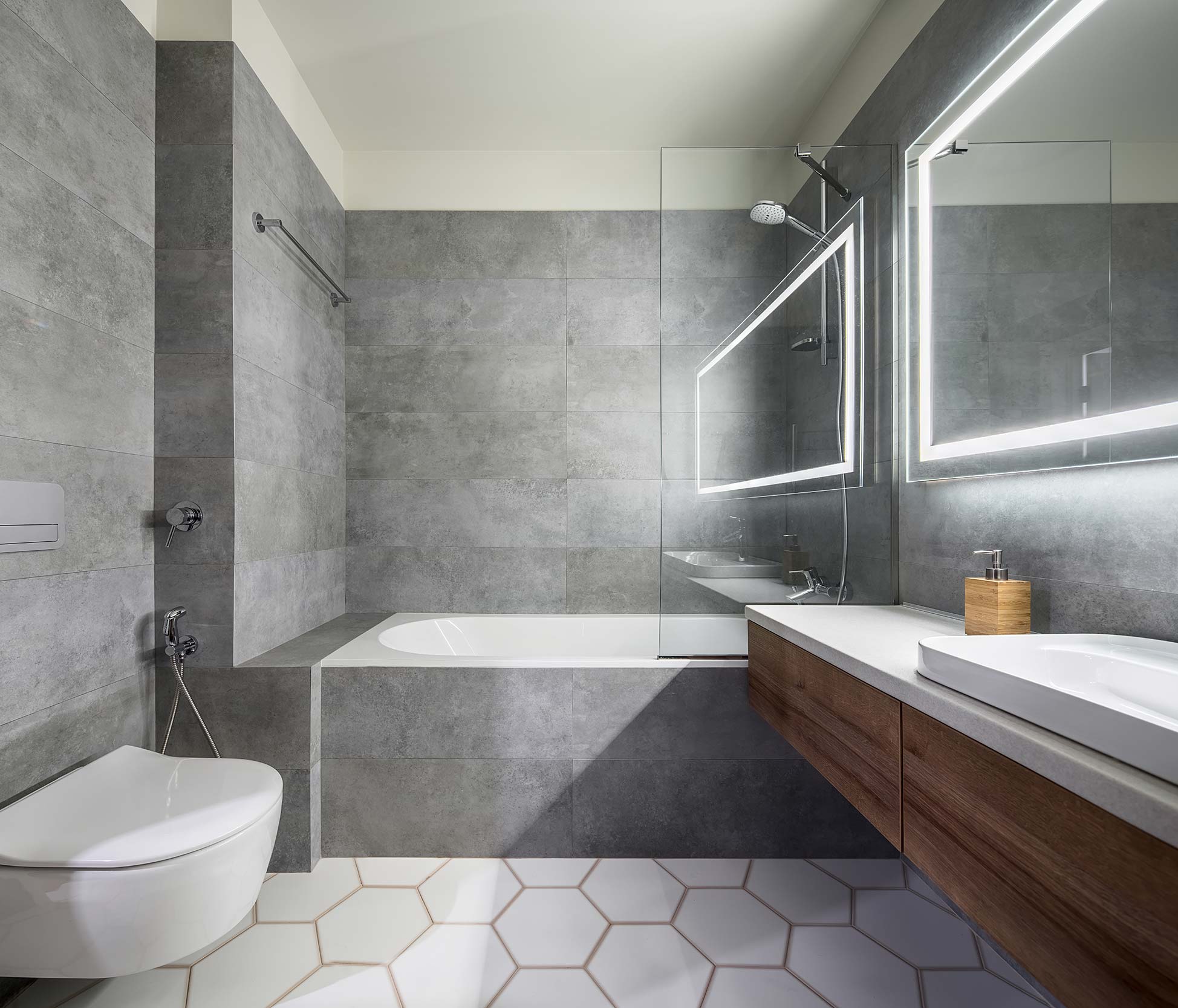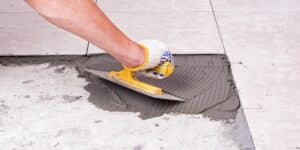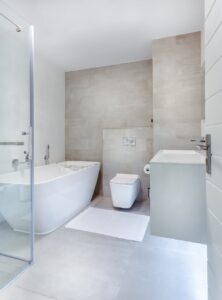Introduction to Tiling
In the vast world of interior design, tiling holds a significant place. From the intricate patterns of ancient civilizations to the sleek designs of modern architectures, the evolution of tiling: from ancient art to modern design, is a fascinating journey.
The Art and Craft of Tiling
The art and craft of tiling have stood the test of time, evolving from being a mere utilitarian element to an essential component of aesthetic expression. Tiles serve as a canvas for artisans, offering unlimited possibilities in colors, patterns, and textures. Craftsmen employ various techniques, including cutting, shaping, and grouting, to create designs that are not only functional but also visually captivating. For more insights into the world of tiling, explore our extensive library of articles on tiling.
The Role of Tiles in Interior Design
In interior design, tiles play a pivotal role. They can dramatically transform a space, adding depth, color, and personality. From kitchens to bathrooms, tiles can be used to create stunning backdrops or eye-catching focal points.
Tiles also offer practical benefits. They are durable, easy to clean, and resistant to moisture and stains, making them a popular choice for high-traffic and wet areas. Our guides on choosing the right tile for your kitchen and maximize your space: expert tips for tiling small bathrooms provide practical advice for incorporating tiles in these spaces.
Furthermore, with advancements in technology and design, tiles are now available in a wide array of materials, sizes, and finishes, catering to every style and budget. Whether you’re drawn to the timeless elegance of marble tiles, the rustic charm of terracotta, or the modern appeal of large-format porcelain tiles, there’s a tile to match your design vision. Stay updated with the latest trends by checking out the top 5 trends in tiling for 2023.
The journey of tiling, from being an essential part of ancient architecture to its integral role in modern interior design, demonstrates its enduring appeal. As we trace the evolution of tiling, it’s clear that this art form will continue to inspire and captivate us for generations to come.
The Ancient Art of Tiling
The history of tiling design is as rich and diverse as the cultures that have contributed to it. Understanding the beginnings of this time-honored craft provides valuable insights into its evolution and sheds light on the origin of modern tiling practices.
Tiling in Ancient Civilizations
The use of tiles for decorative and functional purposes dates back to ancient civilizations. The Egyptians used fired clay tiles as early as 4000 B.C., adorning their palaces and temples with intricate designs. The Greeks and Romans further advanced the art of tiling, using tiles to create elaborate mosaics that depicted mythical scenes, historical events, and portraits of prominent figures.
In Persia, the art of tiling reached new heights during the Islamic period. Persian artisans developed sophisticated techniques to produce tiles with lustrous glazes and intricate patterns. These tiles were used extensively in the decoration of mosques, palaces, and public buildings, reflecting the cultural significance of tiling in Persian society.
In China, the use of ceramic tiles dates back to the Neolithic age. Chinese artisans developed unique techniques for creating glazed ceramic tiles, which were used in the construction of imperial palaces and temples. The influence of Chinese tiling techniques can still be seen in the traditional architecture of East Asia.
Techniques and Materials Used
The early techniques of tile making involved molding clay into the desired shape, decorating it, and then firing it in a kiln. The decoration often involved the use of pigments to create colorful designs. Over time, artisans developed techniques to create tiles with different shapes, colors, and finishes, leading to a wide variety of tiling styles.
The materials used for tiling in ancient times were primarily clay and ceramics, due to their availability and ease of manipulation. The Egyptians used a type of clay called faience, which was glazed to create a lustrous finish. The Greeks and Romans used terracotta, a type of clay that is fired at a high temperature to create a hard, durable tile.
In Persia, artisans used a technique called cuerda seca, which involved applying a dark outline to the design before adding colored glazes. This technique allowed for the creation of intricate, multi-colored designs without the colors bleeding into each other.
In China, artisans used a type of clay called kaolin to create porcelain tiles. These tiles were fired at extremely high temperatures, creating a tile that was white, translucent, and highly durable.
The techniques and materials used in ancient tiling continue to influence modern tiling practices, demonstrating the enduring legacy of this ancient art. Interested in more tiling insights? Visit our in-depth guide on tiling for more information.
The Transition to Modern Tiling
The shift from traditional to modern tiling was largely influenced by various factors, including industrialization and the evolution of tiling materials. These changes significantly shaped the art of tiling, leading to the diverse range of designs, materials, and techniques we see today.
The Influence of Industrialization on Tiling
The advent of industrialization played a pivotal role in transforming traditional tiling practices. With the introduction of machinery and automated production, tiles became more affordable and accessible, leading to their widespread use in homes, public spaces, and commercial buildings.
This period also saw the development of new production techniques, such as the dust-press process, which allowed for the mass production of uniform and high-quality tiles. These techniques facilitated the creation of intricate and detailed designs, expanding the aesthetic possibilities of tiling.
Industrialization also led to advancements in installation techniques. The introduction of tile adhesives, for instance, made the installation process quicker and more efficient. For more information on tile adhesives, check out our article on understanding tile adhesives: a complete guide.
Evolution of Tiling Materials
The evolution of tiling materials has been another significant factor in the transition to modern tiling. While traditional tiling primarily used materials like stone, clay, and ceramic, modern tiling has seen the introduction of a variety of new materials.
One such material is porcelain, which is highly durable and resistant to moisture, making it an ideal choice for bathrooms and kitchens. Glass tiles have also gained popularity for their ability to reflect light and create a sense of spaciousness, making them a popular choice for smaller spaces. For more tips on tiling small spaces, refer to our article on maximize your space: expert tips for tiling small bathrooms.
In recent years, there has been a growing emphasis on sustainable and eco-friendly materials, such as recycled glass and reclaimed wood. These materials not only contribute to environmental sustainability but also offer unique textures and aesthetics. For more information on sustainable tiling options, check out our article on eco-friendly tiling: sustainable choices for your home.
The evolution of tiling materials has provided designers and homeowners with a multitude of options, allowing them to tailor their choices to their specific aesthetic preferences and functional requirements. This diversity of options is a testament to the ever-evolving nature of the art of tiling, underscoring its ability to adapt and innovate in response to changing trends and needs.
Trends in Contemporary Tiling Design
As we trace the evolution of tiling from ancient art to modern design, it becomes clear that contemporary trends have vastly expanded the role and potential of tiles in architecture and interior design. This section explores the increasing use of tiles in modern architecture and the emergence of sustainable and eco-friendly tiling options.
The Use of Tiles in Modern Architecture
Tiles have transcended their traditional role of functional protection and decoration to become an integral part of modern architectural design. They are valued not only for their durability and ease of maintenance but also for their versatility in design and aesthetic appeal. Tiles are now used in innovative ways to create visual interest, define spaces, and establish design themes.
In residential settings, tiles are prominently used in kitchens and bathrooms, where their resistance to water and stains is highly beneficial. However, their use is not limited to these spaces. Tiles are increasingly used in living rooms, dining areas, and outdoor spaces, contributing to a seamless flow of design throughout the home. For guidance on selecting the right tiles for specific areas, refer to our articles on choosing the right tile for your kitchen and maximize your space: expert tips for tiling small bathrooms.
In commercial architecture, tiles play a key role in establishing a professional and polished aesthetic. They are used extensively in office buildings, retail spaces, hotels, and restaurants. For more advanced tiling strategies for commercial projects, see our article on advanced tiling tips for commercial projects.
The use of creative tiling patterns and innovative tiling solutions for challenging spaces has further expanded the design potential of tiles. For more on this, visit our articles on transforming spaces with creative tiling patterns and innovative tiling solutions for challenging spaces.
The Rise of Sustainable and Eco-Friendly Tiles
Another significant trend in contemporary tiling design is the shift towards sustainable and eco-friendly tiles. As consumers become more environmentally conscious, the demand for tiles made from recycled materials or produced through energy-efficient processes is increasing.
Sustainable tiles offer the same range of design options as traditional tiles, enabling homeowners and designers to make eco-friendly choices without compromising on style. They contribute not only to the reduction of environmental impact but also to the creation of healthier indoor environments.
To learn more about sustainable tiling options and how they can enhance your home, check out our article on eco-friendly tiling: sustainable choices for your home.
As part of the continuing evolution of tiling, these trends reflect the adaptability of tiles to changing design philosophies and environmental priorities. Whether you are a homeowner planning a renovation or a professional designer seeking inspiration, staying updated on these trends can help you make informed decisions and create spaces that are both beautiful and functional.
The Future of Tiling Design
As we trace the trajectory of tiling, from its ancient origins to the present day, it’s clear that innovation and technological advancements continue to shape this artform. In the future, we can expect to see further progress in technology and a shift towards customization and personalization in tiling design.
Technological Advances in Tiling
The advancements in technology are set to redefine the future of tiling. From the manufacturing process to the application technique, technology is increasingly influencing every step of the journey.
Digital imaging technology, for instance, has revolutionized tile design. It allows for the creation of tiles with incredibly realistic textures and patterns, mimicking materials like wood, marble, or concrete. This offers homeowners and designers an expanded range of aesthetic choices without compromising on the durability and maintenance benefits of traditional tiles.
In terms of application, tools like tile leveling systems are becoming more advanced, ensuring precision and efficiency. These systems help create a perfectly leveled surface, eliminating unevenness between tiles. For more information on tile leveling systems, refer to our article on tile leveling systems explained: achieving professional results.
Moreover, the advent of 3D printing technology in the tile industry is stirring excitement. This technology can potentially allow for the production of personalized, one-of-a-kind tile designs, opening up new possibilities for customization.
The Shift Towards Customization and Personalization
In line with the broader trends in interior design, the future of tiling is likely to see a greater emphasis on customization and personalization. More and more homeowners are seeking to express their unique style and personality through their choice of tiles.
This trend is facilitated by technological advancements, such as digital printing and 3D printing, which allow for a wider range of tile designs and textures. From customized patterns and colors to personalized motifs and images, the options are virtually limitless.
Furthermore, the rise of ‘mix and match’ tiling, where different types, sizes, and colors of tiles are used together, is indicative of this trend towards personalization. This approach allows for the creation of unique and dynamic spaces, reflecting the individual’s style and taste.
Whether it’s through the choice of materials, patterns, or arrangement techniques, customization and personalization are set to become key elements in the future of tiling design. For creative tiling pattern ideas, refer to our article on transforming spaces with creative tiling patterns.
As we look to the future of tiling design, it’s clear that the evolution of this craft is far from complete. The integration of advanced technology and the growing desire for personalization suggest exciting possibilities for the next chapter in the story of tiling. As always, it’s important to stay informed and embrace new trends, while appreciating the enduring artistry and craftsmanship that lie at the heart of this timeless form of design.
How to Choose Tiles in Line with Current Trends
Selecting the right tiles is crucial in creating a space that aligns with your design needs and the current trends in tiling. This involves understanding your design requirements and leveraging the expertise of a tiling contractor.
Understanding Your Design Needs
Firstly, it’s important to comprehend your own design preferences and needs. Consider the room’s purpose, the style you want to achieve, and the practicalities of different tile materials. For instance, your choices might differ when choosing the right tile for your kitchen as opposed to selecting tiles for a bathroom or living area.
To stay in line with current trends, review design magazines, websites, and social media platforms for inspiration. Our article on the top 5 trends in tiling for 2023 can also provide insights into the latest tiling fashions.
Also, think about the longevity of your tile choice. Trends may change, but the tiles will stay in place for a considerable time. Therefore, striking a balance between current styles and timeless designs can ensure your space remains stylish for years to come.
The Role of a Tiling Contractor in Guiding Design Choices
Tiling contractors bring a wealth of knowledge and experience to any tiling project. They understand the nuances of the tiling process, from the importance of understanding tile adhesives to the application of various grouting techniques for perfect finishes.
In terms of design, a tiling contractor can provide valuable advice on the best tile choices to meet your specific needs and preferences. They will consider factors such as the size of the room, the amount of natural light, and the existing décor. For example, they can provide tips for tiling small bathrooms to maximize space or suggest innovative tiling solutions for challenging spaces.
Furthermore, a tiling contractor stays up-to-date with the latest trends in tiling design and can guide you towards choices that align with contemporary styles. Whether it’s utilizing creative tiling patterns or recommending eco-friendly tiling choices, a contractor’s guidance can be invaluable in creating a beautiful, modern space.
In conclusion, choosing tiles that align with current trends involves understanding your design needs and leveraging the expertise of a tiling contractor. With careful consideration and expert advice, you can create a space that is both trendy and timeless.




